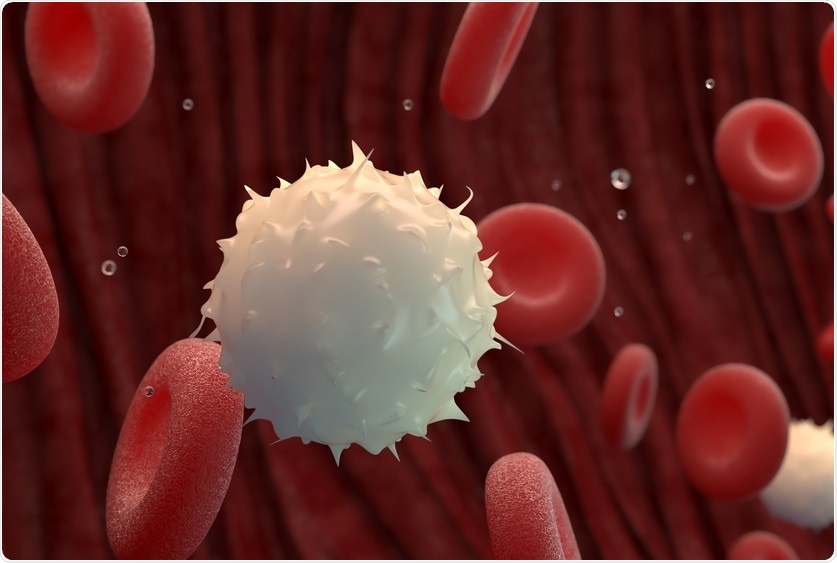According to a recent study by Weill Cornell Medicine researchers, a protein that controls how DNA is wrapped within chromosomes plays a key role in the proper functioning of blood stem cells, which create all of the body’s blood cells.

Illustration of red and white blood cells. Image Credit: Shutterstock.
In plants, mammals, and most other species, the protein—known as histone H3.3—arranges the spool-like structures around which DNA is coiled. Histones allow DNA to be securely compacted and function as platforms for epigenetic changes, which loosen or tighten the bundled DNA to govern local gene activity.
H3.3’s involvement in blood stem cells, commonly known as hematopoietic stem cells (HSCs), was investigated in the study, which was published on December 27th, 2021, in the journal Nature Cell Biology.
HSCs are a significant focus of attempts to create stem-cell-based therapy. Most HSCs remain in a stem-like, uncommitted condition where they can survive indefinitely while slowly self-renewing, while some HSCs develop or “differentiate” to create all of the different lineage-specific blood cell types.
H3.3 is required for both processes, according to the research, and removing it from HSCs resulted in decreased HSC survival, an imbalance in the kinds of blood cells generated by the HSCs and other defects.
“How hematopoietic stem cells coordinate their self-renewal and differentiation into various blood cell types in a balanced way has been a mystery to a great extent, but this study helps us understand those processes much better at the molecular level and gives us many new clues to pursue in further investigations,” stated study co-senior author Dr Shahin Rafii.
Dr Shahin Rafii is the director of the Ansary Stem Cell Institute, chief of the Division of Regenerative Medicine and the Arthur B. Belfer Professor in Genetic Medicine at Weill Cornell Medicine.
Dr Ying Liu and Dr Peipei Guo, both senior instructors in the Rafii Laboratory, were co-first and co-senior authors, as was co-senior author Dr Duancheng Wen, assistant professor of reproductive medicine research in obstetrics and gynecology, and co-author Dr Steven Josefowicz, assistant professor of pathology and laboratory medicine and a member of the Sandra and Edward Meyer Cancer Center, all from Weill Cornell Medicine.
Because of their relevance in health and disease, as well as their promise in regenerative therapy, HSCs are among the most researched stem cells. From red blood cells and platelets to T cells, B cells, and pathogen-engulfing macrophages, a single HSC may give rise to all sorts of blood cells.
A deeper knowledge of how HSCs function might lead to a variety of uses, such as lab-grown blood for transfusions and improved HSC transplants for cancer patients. Furthermore, better understanding how HSCs become leukemias when they acquire aberrant mutations might lead to the development of novel treatments for these often-refractory cancers.
In recent years, biologists have been more interested in H3.3, as evidence of its involvement in HSCs and other stem cells—as well as its participation in many cancers when mutated—has accumulated. However, it is unclear what histone H3.3 performs in HSCs and other cell types where it is found.
Added to the complexity of this project, is that two different genes (H3.3A and H3.3B) code for the same H3.3 protein. Therefore, we had to painstakingly delete both genes in mice by genetic engineering, a herculean task that required a great deal of genetic manipulation of stem cells.”
Dr Duancheng Wen, Study Co-Senior Author and Assistant Professor, Reproductive Medicine Research in Obstetrics and Gynecology, Weill Cornell Medicine
“Our powerful mouse model allows inducible and complete deletion of the H3.3 protein in all organs, or specific types of organs, at selected developmental stage of a mouse,” stated Dr Liu, who is also a research associate in Dr Rafii’s lab.
“Employing this approach, we showed that H3.3’s absence in adulthood primarily causes a depletion of the long-term, self-renewing HSCs on which future blood-cell production depends. At the same time, affected HSCs differentiated into mature blood cell types with an abnormal skew or bias towards certain types of white blood cell, including granulocytes and macrophages.”
“Most importantly, we found evidence that H3.3 has its effects on HSCs in part by anchoring several key epigenetic marks at developmental genes and endogenous retroviruses (ERVs), which are remnants of viruses that once inscribed themselves into our distant evolutionary ancestors’ DNA,” explained Dr Liu.
One intriguing observation was that H3.3’s deletion caused the loss of epigenetic marks that normally suppress ERVs, which led in turn to the activation of an inflammatory response in affected cells, and then drove the cells’ skewed production of blood cell types—a skew that is similar to what is seen in some leukemias.”
Dr Peipei Guo, Study Co-Senior Author and Senior Instructor, Weill Cornell Medicine
H3.3 appears to be acting as a master regulator of self-renewal and differentiation in HSCs—which is wild, and hints at a very broad potential as a therapeutic target someday.”
Andrew Daman, Study Co-Author and Doctoral Candidate, Weill Cornell Graduate School of Medical Sciences
Andrew Daman is a doctoral candidate at Josefowicz laboratory.
“Our take-home message is that normal blood cell development requires the proper epigenetic regulation provided by H3.3,” says Dr Liu.
The researchers are now planning additional research in HSCs and other cell types to learn more about how H3.3 works and what happens when it is not there. More crucially, finding methods to track the H3.3 command of the epigenetic landscape might help them raise blood production more effectively.
“Finally, our team is investigating how H3.3 controls the function of the nurturing niche cells, such as blood vessels that orchestrate stem cell self-renewal and possibly block the emergence of malignancies such as leukemias,” concluded Dr. Rafii, who is also a member of the Meyer Cancer Center.
Source:
Journal reference:
Guo, P., et al. (2022) Histone variant H3.3 maintains adult hematopoietic stem cell homeostasis by enforcing chromatin adaptability. Nature Cell Biology. doi.org/10.1038/s41556-021-00795-7.